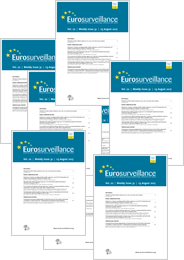- Home
- Weekly releases (1997–2007)
- Previous Issues
- Volume 6, Issue 29, 18/Jul/2002
Weekly releases (1997–2007) - Volume 6, Issue 29, 18 July 2002
Volume 6, Issue 29, 2002
- Articles
-
-
-
Reported synthesis of poliovirus and implications for polio eradication and bioterrorism
More LessIt was announced on 11 July that infectious poliovirus cDNA had been synthesised de novo in a laboratory for the first time (1). Scientists synthesised full length poliovirus cDNA by assembling oligonucleotides of plus and minus strand polarity, and then transcribed them into viral RNA with RNA polymerase. The viral RNA was translated and the synthesis of infectious poliovirus replicated. Transgenic mice injected intracerebrally with this virus developed flaccid paralysis or death, resembling the disease caused by wild poliovirus. The results confirm that the paralysis was caused by the synthetic virus, although a larger inoculum of the synthetic virus was needed to cause paralysis than was the case for wild virus.
-
-
-
Rising incidence of Creutzfeldt-Jakob disease in Switzerland
A Molesworth , S Cousens and H WardMore LessLast week, the Lancet reported on a recent rise in the incidence of Creutzfeldt-Jakob disease (CJD) in Switzerland over a 15 month period. From 1996, the annual number of diagnoses of CJD has been between 8 and 11, corresponding to an annual incidence of about one per million. In 2001 the number of confirmed cases rose to 19, corresponding to an incidence of 2.7 per million, and in the first quarter of 2002, seven cases were identified, which extrapolates to an annual incidence of 3.9 per million this year (1 and figure).
-
-
-
Substantial impact of the HIV pandemic on migrant populations in Europe
More LessAn increasing and disproportionate share of the newly diagnosed HIV infections in Europe – at least in the west – is in migrants, especially in those from sub-Saharan Africa. This was the main conclusion of an analysis of European HIV case reporting data, presented to the XIV International AIDS conference in Barcelona last week (7-12 July 2002) (1). Migrant populations are often highly vulnerable to HIV infection and may experience strong barriers to prevention and care (2).
-
-
-
Sexually transmitted infections may assume an increasingly important role in the evolution of HIV transmission in Europe
More LessFindings presented at the XIV International AIDS conference in Barcelona last week (7-12 July 2002) indicate that sexual transmission of HIV is assuming increasing importance in the western European context, in terms both of increased rates of reported new cases of heterosexual transmission, and of continuing transmission between men who have sex with men (MSM) (1). In some countries, such as the United Kingdom, Belgium and Denmark, relatively high and increasing proportions of new cases of heterosexual HIV transmission occur in migrants from countries with generalised HIV epidemics, where prevalence of sexually transmitted infections (STIs) may also be high (2-4). In other countries, particularly those of southern Europe, there is evidence of significant ongoing heterosexual transmission from injecting drug users (IDUs) (predominantly male) to their sexual partners (5).
-
-
-
Preliminary conclusions of the meeting of the working group of the Network Committee on invasive meningococcal disease due to Neisseria meningitidis serogroup C
F van Loock and F KarcherMore LessA meeting was held with national experts in Luxembourg on 22 May 2002, with the objectives of exchanging information (a) on epidemiological trends in serogroup C invasive meningococcal disease (SCIMD), (b) on vaccination policies for SCIMD in individual countries and (c) on decision criteria used to choose particular vaccination policies.
-
-
-
New issue of EpiNorth online
More LessThe latest issue of EpiNorth (bulletin of the network for infectious disease control in the Barents and Baltic Sea Region) is now available online at www.epinorth.org
-
-
Most Read This Month

-
-
Chikungunya in north-eastern Italy: a summing up of the outbreak
R Angelini , A C Finarelli , P Angelini , C Po , K Petropulacos , G Silvi , P Macini , C Fortuna , G Venturi , F Magurano , C Fiorentini , A Marchi , E Benedetti , P Bucci , S Boros , R Romi , G Majori , M G Ciufolini , L Nicoletti , G Rezza and A Cassone
-
- More Less


